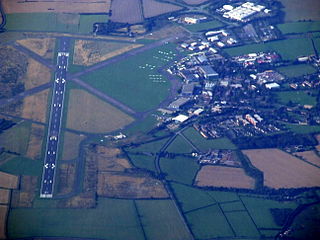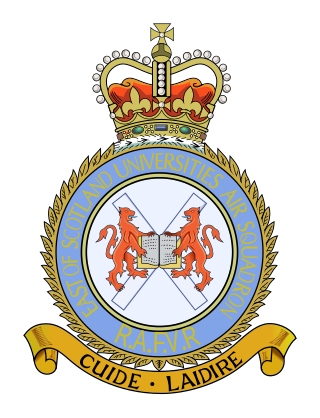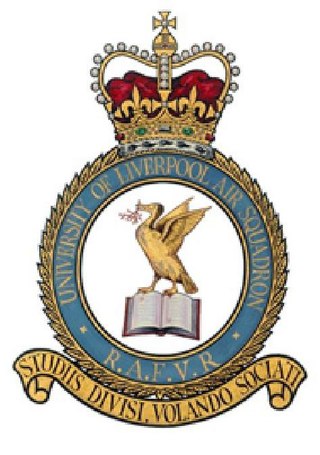
London Biggin Hill Airport is the main international airport serving Biggin Hill in the London Borough of Bromley, located 12 NM south-southeast of Central London. It specialises in general aviation, handling a spectrum of traffic from private aviation to large business jets. It currently has no scheduled airline service, as flights using the airport are not permitted to carry fare-paying passengers.

Royal Air Force Abingdon, or more simply RAF Abingdon, is a former Royal Air Force station near Abingdon, Oxfordshire. It is now known as Dalton Barracks and is used by the Royal Logistic Corps.

Royal Air Force Topcliffe or RAF Topcliffe is a Royal Air Force station in North Yorkshire, England.

The Grob G 115 is a general aviation fixed-wing aircraft, primarily used for flight training. It is built in Germany by Grob Aircraft. The E variant with a 3-blade variable pitch propeller is in service with the Finnish Air Force, the Royal Navy and Army Air Corps for Flying Grading and in the Royal Air Force as part of No. 6 Flying Training School which provides flying to both University Air Squadrons and Air Experience Flights to Cadets of the Royal Air Force Air Cadets. As of 2020, the Tutor is still being used by the RAF for some Elementary Flying Training (3FTS) but is due to be phased out in favour of its replacement, the more advanced Prefect T1.

RAF Andover is a former Royal Flying Corps and Royal Air Force station in England, 2 miles (3.2 km) west of Andover, Hampshire. As well as RFC and RAF units, units of the Aviation Section, U.S. Signal Corps, Royal Canadian Air Force, United States Army Air Forces, and the Air Transport Auxiliary were also stationed at the airfield.
Royal Air Force Turnhouse, or more simply RAF Turnhouse, is a former Royal Air Force Sector Station located in Edinburgh, Scotland. It is now Edinburgh Airport.

Cranfield Airport is an airfield just outside the village of Cranfield, in Bedfordshire, England. It is 7 NM south-west of Bedford and 5.5 NM east of Milton Keynes. It was originally a Second World War aerodrome, RAF Cranfield. It is now used for business aviation, private flights, and for research and development activities.

Newtownards Aerodrome is a local airfield in Newtownards, County Down, Northern Ireland. It is located 8.5 NM east of Belfast. This airport offers light aircraft flights, helicopter flights, microlight flights and flight simulator training. The airport also has an onsite restaurant.

Royal Air Force Colerne or more simply RAF Colerne is a former Royal Air Force station which was on the outskirts of the village of Colerne in Wiltshire, England, and was in use from 1939 to 1976.
Royal Air Force Sydenham or more simply RAF Sydenham is a former Royal Air Force station in Northern Ireland. In the 1970s it was the main servicing base for Blackburn Buccaneer aircraft, employing 650 civilian workers.

Royal Air Force Acklington, simply known as RAF Acklington, is a former Royal Flying Corps and Royal Air Force station located 3.2 miles (5.1 km) south west of Amble, Northumberland and 8.8 miles (14.2 km) north east of Morpeth, Northumberland.

Royal Air Force Driffield or RAF Driffield is a former Royal Air Force station in the East Riding of Yorkshire, in England. It lies about 2 miles (3 km) south-west of Driffield and 11 miles (18 km) north-west of Beverley. It is now operated by the Defence Infrastructure Organisation, as the Driffield Training Area.
Royal Air Force Eastchurch or more simply RAF Eastchurch is a former Royal Air Force station near Eastchurch village, on the Isle of Sheppey, Kent, England. The history of aviation at Eastchurch stretches back to the first decade of the 20th century when it was used as an airfield by members of the Royal Aero Club. The area saw the first flight by a British pilot in Britain.

Royal Air Force Cranage or more simply RAF Cranage is a former Royal Air Force Satellite station operated during the Second World War. It was located just to the North of Middlewich, Cheshire, England.

The East of Scotland Universities Air Squadron, commonly known as ESUAS, is a squadron within the Royal Air Force established in 2003 as an amalgamation of "East Lowlands Universities Air Squadron" (ELUAS) and "Aberdeen, Dundee and St Andrews Universities Air Squadron" (ADStAUAS). It is based at Leuchars Station, in Fife and flies a fleet of six Grob Tutor aircraft. ESUAS is the parent Squadron of No. 12 Air Experience Flight RAF, who share the aircraft.

Liverpool University Air Squadron is a training unit of the Royal Air Force which provides basic flying training, adventurous training and personal development skills to undergraduate students of the University of Liverpool, University of Lancaster, Edge Hill University, Bangor University and Liverpool John Moores University.
Northumbrian Universities Air Squadron is a unit of the Royal Air Force which provides basic flying training, adventurous training and personal development skills to undergraduate students of the University of Durham, University of Newcastle upon Tyne, Northumbria University, Sunderland University and Teesside University. The idea behind all University Air Squadrons is to allow potential RAF officers to experience life in service and to allow them to decide whether they are suited to it. There is no obligation to join up, unless a bursary is successfully applied for. NUAS is parented by RAF Leeming where it flies Grob Tutor aircraft. NUAS Town Headquarters (THQ) are in Newcastle upon Tyne.

Royal Air Force Church Fenton or RAF Church Fenton is a former Royal Air Force (RAF) station located 4.3 miles (6.9 km) south-east of Tadcaster, North Yorkshire, England and 6.3 miles (10.1 km) north-west of Selby, North Yorkshire, near the village of Church Fenton.
No. 6 Flying Training School RAF is a Flying Training School (FTS) within No. 22 (Training) Group of the Royal Air Force that delivers flying training to University Air Squadrons and Air Experience Flights.
















